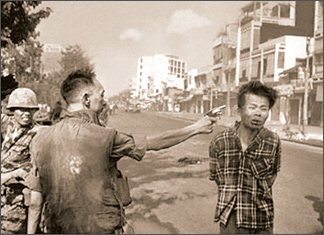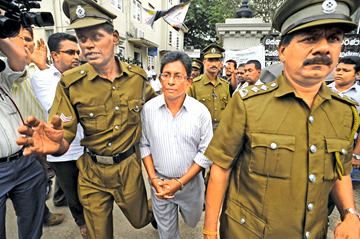Brazen contempt of truth and justice
 Eddie Adams will always be remembered in the annals of war
photography. He served in the United States Marine Corps during the
Korean War as a combat photographer, but some of his most searing
portraits come from his work during the Vietnam War. Eddie Adams will always be remembered in the annals of war
photography. He served in the United States Marine Corps during the
Korean War as a combat photographer, but some of his most searing
portraits come from his work during the Vietnam War.
It was then that he took his best known photograph - a photo so
iconic that it reminds most people of the Vietnam War. He won the
Pulitzer Prize for this photo of Vietnamese Police Chief Nguyen Ngoc
Loan executing a Vietcong prisoner, Nguyen Van Lem, on a Saigon Street
on February 1, 1968, during the opening stages of the Tet Offensive that
eventually saw the defeat and ignominious exit of the US from Vietnam.
There is now a crude and sinister attempt to make what is sought to
be presented as an iconic image of the last days of the war against the
LTTE in Sri Lanka. Set going by the nondescript group of Journalists for
Democracy in Sri Lanka, ably assisted by the UK’s Channel 4 News, the
London Times and BBC, and now interested persons in the United Nations,
too, there is an attempt to create a collective Eddie Adams, of those
who so clearly doctored the video clip of the supposed Tamil civilians
being facing alleged summary execution of prisoners by persons said to
be Sri Lankan troops.
|

Iconic photography by Eddie Adams. Courtesy: Wikipedia |
That this video clip does not stand the test of scientific
examination has already been clearly stated. It was clearly devastating
to BBC and its presenter who brought an employee from the Tamil Service
of BBC TV to comment on the video, when he said there was no way to
establish its authenticity as there was no indication of date, time or
place when the video was made. He added that many such videos
unauthenticated and unverified photos have been seen around for some
time. The world is expected to believe that it was from a mobile phone
of a soldier who was at the alleged killing, based largely on the
Sinhala sounding voices in the background, and the showing of the
persons who did the shooting either in uniforms of Sri Lankan troops or
in camouflage, which latter could be from anywhere.
For those who believe in the absolute truth of the camera, whether
still or video, it is interesting to quote from Eddie Adams himself, on
later reflection about his Pulitzer Prize winning photo known the world
over. Writing to Time magazine about the Police Chief who did that
brutal shooting Adams later said: “The general killed the Viet Cong; I
killed the general with my camera. Still photographs are the most
powerful weapon in the world. People believe them; but photographs do
lie, even without manipulation. They are only half-truths. ... What the
photograph didn’t say was, ‘What would you do if you were the General at
that time and place on that hot day, and you caught the so-called bad
guy after he blew away one, two or three American people?” It is a
strong and compelling statement, which raises a whole lot of new issues
about the conditions under which the Sri Lankan troops had to fight to
defeat the LTTE with its record of brutal terror, without in anyway
lending credibility to the video clip, and the heavily charged
allegation it seeks to make against Sri Lanka, its conduct of the war
and its treatment of civilians affected by war.
The pressure mounts
More than three months after the defeat of the LTTE, and now close to
one month after the arrest of the self-proclaimed successor to
Velupillai Prabhakaran and the controller of its vast reserve of funds,
there is certainly great interest among those who were believing in the
invincibility of the LTTE, to raise new issues to keep up their pressure
on Sri Lanka, and reverse the gains to the country from the defeat of
terrorism.
|

Tissainayagam being taken out of court premises. File photo |
We see how the Channel 4 and video clip, was well in sync with the
meeting of the United States US Institute for Peace (USIP) in Washington
D.C. Workshop on Peace and Reconciliation in Sri Lanka on Friday August
28.
What is significant about this USIP’s so-called initiative, by an
allegedly non-government body funded by the US Congress, is that its
workshop for “Peace and Reconciliation in Sri Lanka”, having as its main
speakers Pakiasothy Saravanamuttu of the Centre for Policy Alternatives
and Jehan Perera of the National Peace Council, and moderated (if that
could be the proper word) by Teresita Schaffer of The Center for
Strategic and International Studies, once the US Ambassador to Sri
Lanka. All three of them have shown very strong support for the position
of the LTTE, and have always thought it proper to lump the Sri Lankan
State with the LTTE, a clearly identified terrorist organization,
especially by the United States.
When looking at the synchronization of events one can also see the
report of the alleged death threat to Pakiasothy Saravanamuttu by post,
a few weeks ago also being an interesting coincidence, coming so close
to the sinister fake of Channel 4 and this workshop of the USIP.
Ratcheting
While the voices ranged against Sri Lanka are getting increasingly
strident, especially with regard to the Channel 4 video and the
ratcheting of calls for international investigations into non-existent
allegations of war crimes et al, there is now a most unusual development
that these forces are using in their propaganda blitz against Sri Lanka.
It is the adherence by Sri Lanka to the Rule of Law.
J. Tissainayagam has been a cause celebre for the anti-Sri Lanka
lobby from the time of his arrest, with organizations such as Amnesty
International organizing a massive letter writing campaign calling for
his release, and Reporters sans Frontiers (RsF) and Human Rights Watch
making crude attempts to get President Rajapaksa to intervene and even
interfere with the judicial process in his case.
Now that the High Court has given its considered verdict,
Tissainayagam is thrust forward as new image of intolerance of dissent
in Sri Lanka, with a special journalism award, and even President Barack
Obama, being prompted to cite him as an example of the intolerance of
Freedom of Expression and Media Freedom in these parts of the world.
It is necessary to pause to ask President Barack Obama, who correctly
decided to close down Guantanamo, what comments he had ever made about
the Al Jazeera photo journalist Sami Al-Haj, who was illegally detained
and tortured by US authorities for seven years in Guantanamo, before
being released in May 2008 with no charge laid against him.
One must also question Obama’s silence about Bilal Hussein, an Iraqi
photojournalist for The Associated Press, who was been held in a U.S.
prison in Iraq for a year without charge, until his release in April
2008, by an Iraqi Court after new agreements with the US.
In contrast the issue of J. Tissainayagam, which a New York Times
journalist told me sent chills down the spine of some Sri Lankan
journalists, was one where there was absolute due process, under a legal
system inherited from the British. He was detained for a length of time
allowed under the Emergency Laws in place, which are renewed each month
by Parliament, which is the supreme legislature of the land.
Tissainayagam, unlike the Al Jazeera and AP journalist from Iraq, had
access to his lawyers, was adequately defended by learned counsel, and
also had persons of good social standing give witness on his behalf. It
was the final decision of the Court after weighing all evidence placed
before it, not just the writing of two articles as alleged, but also
obtaining funds from a terrorist organization that led to his being
sentenced to 20 years RI on three charges.
What is being wholly ignored is that he has two more chances for
appeal -to the Court of Appeal and the Supreme Court of Sri Lanka, both
of which have been known to show little hesitancy in turning down bad
judgments made in, lower courts, which speaks much for the independence
of the judiciary in Sri Lanka.
There is a rowdy raving today about the sentencing of Tissainayagam
and even calls for an immediate pardon by the President even before the
ink is dry on the order given by the learned High Court Judge, and with
not even a scrap of paper being produced as to why the President should,
exercise his prerogative in this instance alone, when there are many
others found guilty of involvement with terrorism.
The lesser the unthinking screams about the Tissainayagam Case, the
better it will be for him, and for the further strengthening of the Rule
of Law here. One can have intelligent discussions about this verdict,
but certainly not go down to the depths of RsF which said this”
extremely severe sentence on Tissainayagam suggests that some Sri Lanka
judges confuse justice with revenge,” ......and went on to state that
“We strongly hope that the appeal process adheres to the facts of the
case and the spirit of the law.” There is more here than a touch of
contempt for the judiciary both in the trial already concluded and in a
possible appeal that may be heard later. Such strident voices do not
serve the cause of justice for Tissainayagam or media freedom. |



